|
Mt. Tai (Taishan)
 |
 |
The
Top of Mount Tai |
Mount
Tai Inscriptions |
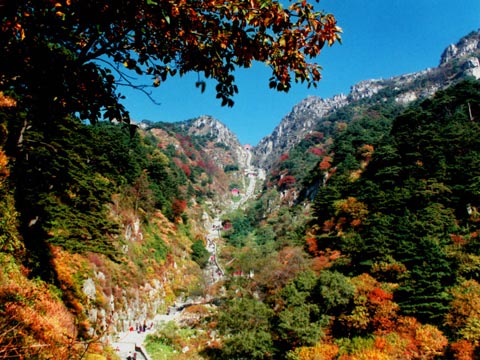 |
 |
Eighteen
Bens of The Stairway |
Sun
Rising From the Cloud |
Mt.Taishan locates in Taian City of Shandong Province. With the height of 1532 meters, it is regarded as the Chief of “Five Sacred Mountains” in China. For 2,000 years Mt. Tai was the object for Chinese emperors to pilgrimage. According to historical records, 72 emperors once visited Mt. Tai and held sacrificial ceremonies on Mt. Tai. Many scholars were inspired by Mt. Tai to leave abundant poems, easies and inscriptions. That added rich cultural atmosphere to the beautiful landscape of Mt. Tai. Mt. Tai also played an important role in the development of Buddhism and Taoism.
Mt. Tai is also famous for its ancient architectures. Dai Temple at the foot of the mountain is one of several major palace architectural complexes in China. The Azure Clouds Temple near the top of the mountain (Jade Emperor Summit) is another grand building complex with a special combination of metal components, wood, and bricks and stone structures. From the Taishan Temple to the Azure Clouds Temple there are numerous stone tablets and inscriptions and ancient buildings on the way. Visitors can enjoy much pleasure from climbing Mt.Tai. From the red gate at the foot of the mountain to the South Heaven Gate there are around 7,000 stone steps. Each step offers a different view.
Mt. Tai is famous for its four natural wonders: Sunrises from the East, the Sunset Glow, the Sea of Clouds and the Golden Belt along the Yellow River. Mt. Tai was listed in the World Natural and Cultural Heritage List of UNESCO in 1987. The Yellow Mountain (Huangshan)
The Yellow Mountain is called Huangshan in Chinese. It is a mountain range in southern Anhui province in Eastern China.
The mountains were formed in the Mesozoic, about 100 million years ago, when an ancient sea disappeared due to uplift of the earth’s surface. Later, in the Quaternary, the landscape was shaped by the influence of glaciers.
 |
 |
The
Yellow Mountain |
The
Welcoming Pine on Yello Mountain |
 |
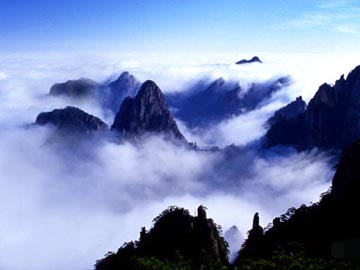 |
The
Flying Stone on Yello Mountain |
The
Cloud Sea Floating through Yellow Mountain |
The Yellow Mountains are a marvel with a lot of mountains above 1000meters high. There are three peaks such as Lotus peak; Brightness Summit and Celestial Capital Peak exceeding 1800meters high. The Yellow Mountains change their colors and appearance magically with the alternation of seasons and weather. The mountains are a body of granite, often with vertical joints. Erosion and fracture contributed to shape the rocks into huge columns giving rise to lofty peaks and deep ravines. When it is cloudy the pinnacles loom in mists as if they were visionary, while in sunshine they unfold in all their majesty and splendor. In winter time silver branches of trees and rocks please people’s eyes in special view.
Owing to the peculiar terrain, the distribution of vegetation is also distinctive: plants on the summit, on the middle levels and at the foot belong to the frigid, temperate and subtropical zones respectively. There are many rare species of plants growing in Huangshan such as firs, ginkgoes, camphor woods Chinese sweet gums, Chinese goldthread rhizome, Chinese cinnamon and so on. So the Yellow Mountains are important for botanical research in China. The world famous green tea, Huangshan Mao Feng Tea, named from the downy tea leaves is also produced in Huangshan.
The fantastic pines, the grotesque rocks, the mysterious sea of clouds and the clearly hot springs are the four major wonders of the Yellow Mountains.
The Yellow Mountain has been a UNESCO World Heritage Site since 1990 for its natural beauty and its rare species of plants.
Mt.Wudang (Wudangshan)
Mt. Wudang is Located southwest of Danjiangkou City, Hubei Province. It is a famous Taoism resort. It is a combination of natural scenery and man-made sight. Mt.Wudang is famous for its natural scenery, magnificent ancient building complex, martial arts tradition and Taoism culture.
 |
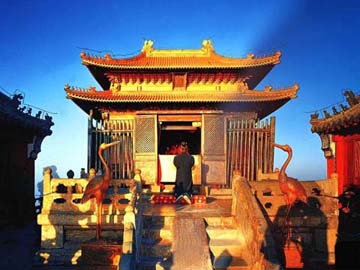 |
The
Summit of Mount Wudang |
The
Coper Palace on Mount Wudang |
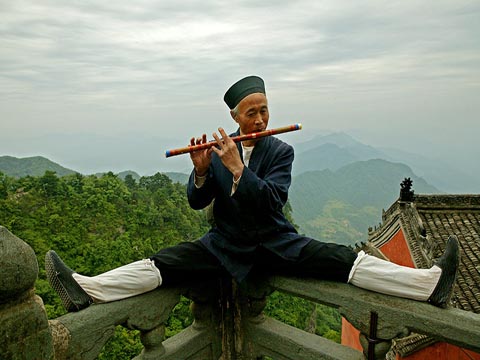 |
 |
Daoist
Blowing Flute |
Daoists
Practising Martial Art |
The magnificent and grand ancient buildings were built in the Tang, Song, Yuan, Ming and Qing dynasties. There are 72 temples, 39 bridges, 36 nunneries and 12 pavilions. Among them the Golden Palace is most famous. Standing on the summit of the 1612 meters high mountain, it is the main palace and well-preserved. Built in 1416 AD, it is 5.54 meters high, 4.4 meters wide and 3.15 meters deep. The whole building was made of cast copper structures gilded by gold. So seen from the distance, the Golden Palace is brilliant and magnificent. A 10-ton bronze statue of Zhenwu Emperor is erected in the palace. Standing on the top of the Golden Palace, you will have everything in view.
The Wudang Martial Arts enjoys great popularity, both in China and abroad. Students of Martial Arts travel from all over the world to study with the masters in Wudang. The legends said that Zhang Sanfeng, one famous Taoist who invented the Taiji in Mt. Wudang after he was inspired by a fight between a magpie and a snake.
Mt.Wudang is also a cradle of Taoist culture in China. Many Taoists once cultivated themselves in the Mt.Wudang. Many emperors of different dynasties also contribute to build Taoist temples for publicizing the Taoist culture.
In summary, the ancient building complex in the Mt.Wudang is a bright pearl in China. Also in 1994, it was listed as the world cultural heritage by UNESCO.
Mt.Emei (EmeiShan)
Mt. Emei is located in Leshan City, Sichuan Province. It is like a huge green screen standing in the southwest of the Chengdu Plain. The shape of the mountain is like the eyebrow of a beautiful girl. The height of Emei Mountain is over 3000 meters. In 1996 Mt. Emei was enlisted in the world natural and cultural heritage by the UNESCO.
Mt. Emei is well-known for its enjoyable natural scenery, extensive Buddhist culture, abundant range of species and unique landform. Thus it gets such titles as 'Kingdom of Plants', 'Geological Museum', 'Animals' Paradise' and 'Buddhist Celestial Mountain'.
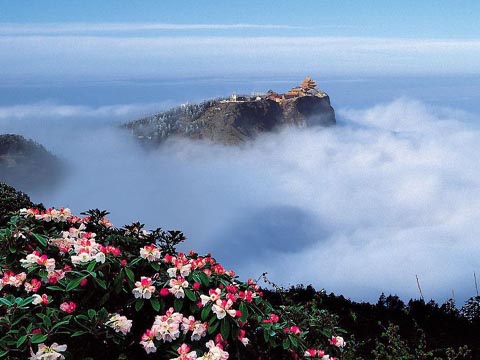 |
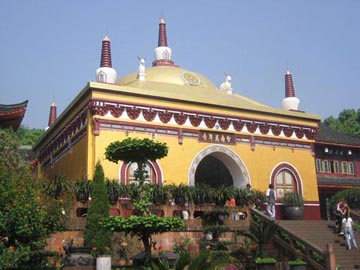 |
Mount
Emei |
Temple |
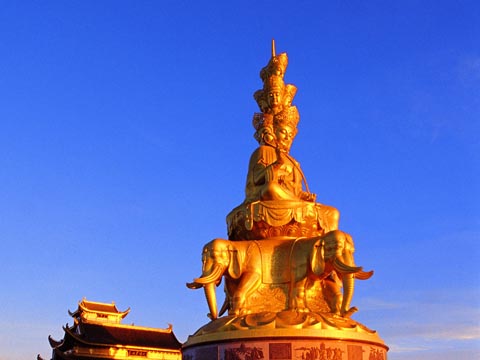 |
 |
Buddha
Samantabhadra Statue |
Monks
on Religious Ceremony |
Due to the mild climate and fertile soil, the mountain is covered by many kinds of trees, bushes, grass and flowers. The scenery all the year round is beautiful and in varied views. It is also the habitats for rare plants and animals such as rhododendron, camphor and small panda. Mt. Emei was created by the Himalayan mountain-building movement and the later uplift of the Qinghai-Tibet Plateau. It contains geological features of all the periods following the Cambrian period.
Mt. Emei is one of the four celebrated Buddhist Mountains in China. It is said that Buddhism was brought to Mt. Emei in the first century BC. After nearly 2,000 years of development, Mt. Emei has become a place rich in Buddhist heritage, which has made it an influential sacred place in China and even in the whole world.
There are vivid and exquisite statues of Buddha made of clay, wood, jade, bronze and porcelain. There are a lot of Buddhist temples on the Mt.Emei. Baoguo Temple built in the Ming Dynasty. It housed a 2.4 meters high porcelain Buddha statue. The big bell weights 12.5 tons casting with 6000 characters. Fuhu Temple, built in the Yuan Dynasty, has 13 halls. There is a 6-meter high, 17 storied bronze tower made in the Yuan Dynasty with 4000 engraved Buddhist figures on it. The 2000 character Guayan Sutras are well preserved in the temple. Wannian Temple, built in the Saong Dynasty, has a huge bronze statue of Samantabhadra riding on an elephant. The statue is 7.35 meters high and weights 62 tons. The Copper Hall with a gold plated roof in Woyun Temple, built in the Ming Dynasty, which is 8 meters high, 4.8 meter wde and 4.3 meter deep. There is a 5 meters high bronze statue of Buddha. Ousde the hall is a bronze tablet on which 2564 characters of the scripts of calligrapher Wan Xi zhi of the East Jin Dynasty (317-420AD) and Chu Suiliang of the Tang Dynasty (618-907AD) were engraved. The tablet was valued as the treasure of Mt.Emei.
Wonders of Mt.Emei
Sun Rise
In Golden Summit, the sky before the dawn is amazing. The ground and the sky are in the dark purple. Then gradually rosy clouds appear above the horizon indicating the sunrise. Under the pink clouds on the royal purple sky, a small mauve point comes out and rises slowly, and then little by little it becomes an arc and then a semicircle. The color turns from mauve to jacinth and then golden red. At last the whole sun appears in the east sky. After the sunrise, millions of sun rays shoot onto the ground. At this time the Mt. Emei is gold in color, from the top to the foot, showing all her glamour to people.
Clouds Sea
Blue white clouds may raise slowly among the mountain although the sky is clearly. Just in a moment, vast clouds sea appears above the horizon like a snowy white woolen blanket, smooth, clean and thick. Sometimes there are clouds either above the horizon or in the sky, so people stand between two clouds layers, which make you feel like a supernatural being. When wind comes, the clouds sea is wafted to all the directions and then mountains become small islands floating in a sea; when the clouds sea gathers together, peaks are invisible again; when wind gets strong, the clouds sea sometimes moves at a full gallop like a horse; sometimes makes a welter like boiling water; sometimes becomes elegant and stretching like a fair lady.
Buddha Rays
In the afternoon, at the foot of the Sheshen Rock, every place is full of pure white clouds. Then an aura with the color of red, orange, yellow, green, black blue, blue and purple extends within a radius of around one to two meters. It looms and shines in the center like a mirror. Back against the sunlight from the west, sometimes you can find your own shadow in the aura as if you were facing a bright mirror. To your most surprise, even if many people were viewing at it or two persons hugging each other were enjoying it, they could only see themselves. This is really a marvelous spectacle of Mt. Emei.
Saint Lamps
In the dark nights, on the peak of Mt. Emei, occasionally, you can see points of fluorescence flowing between the valleys which are like lamps. This is the famous scenery saint lamps in Mt. Emei. But it is rare to see now.
Mobile:(+86-1350 110 3837) Wechat:(13501103837) E-mail: chinasilkrug@msn.com